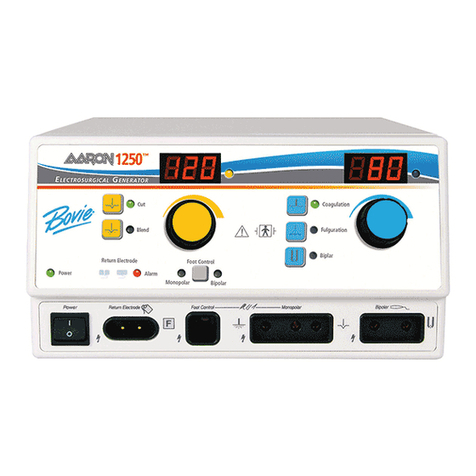Bovie SPECIALIST PRO User manual

SPECIALIST | PRO
Electrosurgical Generator
User’s Guide

USER’S GUIDE
User’s Guide • Specialist | RO 1

2 Bov ie M e di ca l Co r po rat io n

This manual and the equipment it describes are for use only by qualified medical professionals trained in the particular technique
and surgical procedure to be performed. It is intended as a guide for using the Specialist│PRO only.
Additional technical information is available in the Specialist│PRO Service Guide. For the latest information and technical
bulletins, visit www.boviemed.com.
Equipment C vered in this Manual
User’s Guide • Specialist│PRO
Reference No.: A1250S
F r Inf rmati n C ntact
Bovie Medical • Clearwater, F 33760-4004
U.S. & Canada Phone +1 800-251-3000 • Int’l. Phone +1 615-964-5532
BovieMedical.com • Sales@BovieMed.com
Emergo Europe
Prinsessegracht 20
2514 AP, The Hague
The Netherlands
Printed in USA
©2019 Bovie Medical Corporation. All rights reserved. Contents of this publication may not be reproduced without the written per-
mission of Bovie Medical Corporation.
Bovie® Part Number MC-55-237-001_4-EN
CONVENTIONS USED IN THIS GUIDE
WARNING:
Ind cates a potent ally hazardous s tuat on wh ch, f not avo ded, could result n death or ser ous
njury.
CAUTION:
Ind cates a hazardous s tuat on wh ch, f not avo ded, may result n m nor or moderate njury.
NOTICE:
Indi ates an operating tip, a maintenan e suggestion, or a hazard that may result in produ t
damage.
3User’s Guide • Specialist | RO

Bov ie M e di ca l Co r po rat io n4
TABLE OF CONTENTS
Preface ......................................................................................................................................3
Equipment Covered in this Manual................................................................................3
For Information Contact .................................................................................................3
Conventions Used in this Guide ............................................................................................3
List of Figures...........................................................................................................................6
Sec ion 1 – In roducing he Specialis | PRO Elec rosurgical Genera or..........................7
Indications for Use ..................................................................................................................8
Operating Principles................................................................................................................8
Intended Use ...........................................................................................................................8
Key Features .............................................................................................................................8
Components and Accessories..................................................................................................9
Safety ........................................................................................................................................9
Warnings..................................................................................................................................9
Cautions..........................................................................................................................11
Contraindications..................................................................................................................12
Notices ............................................................................................................................12
Application Specifications.....................................................................................................12
Operating Conditions ....................................................................................................12
Sec ion 2 – Con rols, Indica ors, and Recep acles .............................................................15
Front Panel.............................................................................................................................16
Symbols on the Front Panel ..................................................................................................17
Cut and Blend Controls........................................................................................................18
Coag and Bipolar Controls ...................................................................................................19
Indicators ...............................................................................................................................20
Power Switch and Receptacles ...............................................................................................21
Rear Panel ..............................................................................................................................22
Symbols on the Rear Panel....................................................................................................22
Sec ion 3 – Ge ing S ar ed ..................................................................................................23
Initial Inspection....................................................................................................................24
Installation .............................................................................................................................24
Function Checks....................................................................................................................24
Setting Up the Unit...............................................................................................................24
Checking the Patient Return Electrode Alarm.....................................................................24
Confirming Modes ................................................................................................................25
Checking Bipolar Mode (with Footswitch)....................................................................25
Checking Monopolar Mode (with Footswitch) .............................................................25
Checking Monopolar Mode (with Handswitch) ...........................................................25
Performance Checks..............................................................................................................25
Sec ion 4 – Using he Specialis | PRO Elec rosurgical Genera or ..................................27
Inspecting the Generator and Accessories............................................................................28
Setup Safety............................................................................................................................28
Warnings ........................................................................................................................28
Cautions .........................................................................................................................29
Notices ............................................................................................................................30
Setting Up..............................................................................................................................30
Preparing for Monopolar Surgery .........................................................................................30

User’s Guide • Specialist | RO 5
Applying the Patient Return Electrode .........................................................................30
Connecting Accessories..................................................................................................31
Preparing for Bipolar Surgery................................................................................................31
Activation Safety ....................................................................................................................31
Warnings.........................................................................................................................31
Cautions .........................................................................................................................32
Activating the Unit................................................................................................................33
Notices ............................................................................................................................33
Sec ion 5 – Main aining he Specialis | PRO Elec rosurgical Genera or .......................35
Cleaning.................................................................................................................................36
Periodic Inspection ................................................................................................................36
Fuse Replacement..................................................................................................................36
Sec ion 6 – Troubleshoo ing ................................................................................................37
Error Codes ...........................................................................................................................38
Sec ion 7 – Repair Policy and Procedures ..........................................................................39
Responsibility of the Manufacturer.......................................................................................40
Returning the Generator for Service ....................................................................................40
Step 1 – Obtain a Returned Goods Authorization Number........................................40
Step 2 – Clean the Generator........................................................................................40
Step 3 – Ship the Generator..........................................................................................40
Appendix A - Technical Specifica ions ................................................................................41
Performance Characteristics..................................................................................................42
Input Power ....................................................................................................................42
Duty Cycle......................................................................................................................42
Dimensions and Weight ................................................................................................42
Operating Parameters.....................................................................................................42
Transport ........................................................................................................................42
Storage ............................................................................................................................42
Audio Volume ................................................................................................................43
Activation Tone .........................................................................................................43
Alarm Tone ................................................................................................................43
Return Electrode Sensing ..............................................................................................43
Low Frequency (50–60 Hz) Leakage Current................................................................43
High Frequency (RF) Leakage Current .........................................................................44
Operating Conditions....................................................................................................44
Standards and IEC Classifications........................................................................................44
Class I Equipment (IEC 60601-1)..................................................................................44
Type BF Equipment (IEC 60601-1) / Defibrillator Proof.............................................44
Drip Proof (IEC 60601-2-2) ...........................................................................................44
Electromagnetic Interference .........................................................................................44
Electromagnetic Compatibility (IEC 60601-1-2 and IEC 60601-2-2) ...........................44
Voltage Transients (Emergency Generator Mains Transfer)..........................................44
EMC Compliance..................................................................................................................45
Output Characteristics...........................................................................................................47
Maximum Output for Monopolar and Bipolar Modes ................................................48
Output Power Curves ............................................................................................................49

Bov ie M e di ca l Co r po rat io n6
Appendix B – Warran y .......................................................................................................51
The Specialist | PRO Electrosurgical Generator Warranty..................................................51
LIST OF FIGURES
Figure 2 – 1 Layout of controls, indicators, and receptacles on the front panel ................16
Figure 2 – 2 Controls for the Cut and Blend modes ..........................................................18
Figure 2 – 3 Controls for the Coagulation, Fulguration, and Bipolar modes....................19
Figure 2 – 4 Indicators for power, return electrodes, and footswitch control ....................20
Figure 2 – 5 Location of the unit power switch and front panel receptacles .....................21
Figure 2 – 6 Layout of connectors and controls on the rear panel ....................................22
Figure A – 1 Output voltage vs power setting (Cut, Coag) .................................................47
Figure A – 2 Output voltage vs power setting (Bipolar) ......................................................47
Figure A – 3 Output power vs power settings for all modes ...............................................48
Figure A – 4 Output power versus impedance for Cut mode.............................................48
Figure A – 5 Output power vs impedance for Blend mode................................................49
Figure A – 6 Output power vs impedance for Coagulation mode .....................................49
Figure A – 7 Output power vs impedance for Fulguration mode ......................................50
Figure A – 8 Output power vs impedance for Bipolar mode..............................................50

User’s Guide • Specialist | RO 7
INTRODUCING THE SPECIALIST | PRO
ELECTROSURGICAL GENERATOR
This section includes the following information:
● Indications for Use
● Operating Principles
● Intended Use
● Key Features
● Components and Accessories
● Safety
● Contraindications
● Application Specification
CAUTIONS
Read all warnings, cautions, and instructions provided with this generator before using.
Read the instructions, warnings, and cautions provided with electrosurgical accessories before
using. Specific instructions are not included in this manual.

INDICATIONS FOR USE
The Specialist | PRO Electrosurgical enerator is used to deliver RF energy via an assortment of surgical devices to cut
and coagulate different kinds of tissue. For the latest user information and technical bulletins, contact Bovie Medical
Corporation.
O ERATING RINCI LES
The Specialist | PRO enerator is a high frequency isolated generator featuring cutting up to 120 watts, a blend
mode, 2 coagulation modes and 1 bipolar mode. The generator offers a monopolar handpiece output, monopolar
foot controlled output and bipolar foot controlled output.
INTENDED USE
The Specialist | PRO Electrosurgical enerator is intended to be used for all electrosurgical cut, blend, coagulation,
fulguration and bipolar procedures.
NOTICE:
The Spe ialist | PRO is not intended for Tubal Ligation.
KEY FEATURES
The Specialist | PRO Electrosurgical Generator includes the latest technology. This unit offers unsurpassed
performance, flexibility, reliability, and convenience.
It includes the following features:
• Two levels of coagula ion: Pinpoin Coagula ion and Fulgura ion
Pinpoint Coagulation provides precise control of bleeding in localized areas.
Fulguration provides greater control of bleeding in highly vascular tissue over broad surface areas.
• Memory
The unit automatically powers up to the last selected modes and power settings.
• Isola ed RF ou pu
This minimizes the potential of alternate site burns.
• S andard connec ors
These connectors accept the latest monopolar and bipolar instruments.
• Self diagnos ics
These diagnostics continually monitor the unit to ensure proper performance.
• Return electrode sensing and contact quality monitoring
The Specialist | PRO incorporates a return electrode contact quality monitoring system (Bovie NEM™). This system detects
the type of return electrode: solid or split. The system also continually monitors the contact quality between the patient and the
split return electrode. This feature is designed to minimize patient burns at the return electrode site.
NOTICES:
The Bovie NEM™ system re ommends that you use a split return ele trode.
Before a tivation, pad pla ement and visual verifi ation of the split return ele trode (split pad)
indi ator on the front panel is re ommended. After onne ting the split pad to the generator and
pla ing the split pad se urely to the patient, give the unit 3 se onds to re ognize the split pad. The
split pad indi ator will illuminate green. If the split pad and ord are atta hed to the
generator without se ure onta t to the patient, the alarm indi ator will illuminate red.
8 Bov ie M e di ca l Co r po rat io n

COMPONENTS AND ACCESSORIES
To avoid incompatibility and unsafe operation, we recommend using the following Bovie®brand accessories supplied
with your generator:
•Specialist | PRO Electrosurgical enerator
• Hospital-grade power cords - 09-039-001; 09-035-001
measuring 15 feet (4.572 meters)
• User’s uide (s)
ADDITIONAL ACCESSORIES
To avoid incompatibility and unsafe operation, we recommend using the following Bovie®accessories with
the Specialist│PRO:
• BV-1253B - Footswitch for Monopolar and Bipolar procedures
SAFETY
The safe and effective use of electrosurgery depends to a large degree on factors solely under the control of the
operator. There is no substitute for a properly trained and vigilant medical staff. It is important that they read,
understand, and follow the operating instructions supplied with this electrosurgical equipment.
Physicians have used electrosurgical equipment safely in numerous procedures. Before starting any surgical procedure,
the surgeon should be familiar with the medical literature, complications, and hazards of using electrosurgery in that
procedure.
To promote the safe use of the Specialist | PRO Electrosurgical Generator, this section presents the warnings and
cautions that appear throughout this user’s guide. So that you can operate this equipment with maximum safety,
it is important that you read, understand, and follow the instructions in these warnings and cautions. It is also
important that you read, understand, and follow the instructions for use in this user’s guide.
WA NINGS
Hazardous Electrical Output - This equipment is for use only by trained, licensed physicians.
Danger: Fire / Explosion Hazard - Do not use the Specialist | PRO electrosurgical generator in
the presence of flammable anesthetics.
Fire / Explosion Hazard - The following substances will contribute to increased fire and
explosion hazards in the operating room:
• lammable substances (such as alcohol based skin prepping agents and tinctures)
• Naturally occurring flammable gases which may accumulate in body cavities such as
the bowel
• Oxygen enriched atmospheres
• Oxidizing agents (such as nitrous oxide [N20] atmospheres).
The sparking and heating associated with electrosurgery can provide an ignition source.
Observe fire precautions at all times. When using electrosurgery in the same room with any
of these substances or gases, prevent their accumulation or pooling under surgical drapes,
or within the area where electrosurgery is performed.
Connect the power cord to a properly polarized and grounded power source with the frequency
and voltage characteristics that match those listed on the back of the unit.
No mod f cat on of th s equ pment s allowed.
Electric Shock Hazard - Connect the generator power cord to a properly grounded receptacle. Do
not use power plug adapters.
Electric Shock Hazard - Always turn off and unplug the generator before cleaning.
Fire Hazard - Do not use extension cords.
Patient Safety - Use the generator only if the self-test has been completed as described.
9User’s Guide • Specialist | RO
• One disposable pencil - ESP1-S
• Three electrodes - ES20 (ball); ES02 (needle); ES01 (blade)
• One reusable grounding cord - A1252C
measuring 9.85 feet (3 meters)
• Five disposable split grounding pads -ESRE-1
• ESU Series I DVD

Otherwise, inaccurate power outputs may result.
ailure of the high frequency electrosurgical equipment could result in an unintended increase
of output power.
The instrument receptacles on this generator are designed to accept only one instrument at
a time. Do not attempt to connect more than one instrument at a time into a given receptacle.
Doing so will cause simultaneous activation of the instruments.
Use the lowest output setting necessary to achieve the desired surgical effect. Use the active elec-
trode only for the minimum time necessary in order to lessen the possibility of unintended burn
injury. Pediatric applications and/or procedures performed on small anatomic structures
may require reduced power settings. The higher the current flow, and the longer the current is
applied, the greater the possibility of unintended thermal damage to tissue, especially during
use on small structures.
or all monopolar modes, if the Generator is activated with the rated duty cycle of 10 seconds on /
30 seconds off, the surface skin temperature under the Bovie® patient return pads will not rise by
more than 6°C if the skin and pad are prepared properly. However, be aware that activation times
longer than the rated duty cycle of 10 seconds on / 30 seconds off, particularly at high power
settings, the surface skin that is under the Bovie patient return pads may continue increasing in
temperature by more than 6°C.
Avoid using power settings that would exceed the highest maximum voltage that is acceptable for
each accessory. Choose only accessories that will withstand each mode and power setting.
To avoid incompatibility and unsafe operation, use suitable cables, accessories, active and neutral
electrodes, including values for the highest allowed H. . peak voltage.
Some accessories have multiple buttons that can deliver different surgical effects. Verify
accessory features and proper mode settings prior to activation.
Connected accessories need be rated for at least the maximum peak output voltage of the H. .
generator set at the intended output control setting in the intended operating mode.
Associated equipment and accessories used must be rated to withstand the combination of the
Vpeak rating and Crest actor for the following R modes, Blend, Pinpoint and Spray.
The output power selected should be as low as possible for the intended purpose. Certain devices
or accessories may present a safety hazard at low power settings.
Apparent low output or failure of the Specialist | PRO to function correctly at the normal operating
settings may indicate faulty application of the neutral electrode or poor contact in its connections.
In this case, the application of the neutral electrode and its connections should be checked before
selecting a higher output power.
When using Cut mode, associated equipment and active accessories should be selected that have
a rated accessory voltage equal to or greater than 1250 Vpeak max.
When using Blend mode, associated equipment and active accessories should be selected that
have a rated accessory voltage equal to or greater than 1850 Vpeak max.
When using Coagulation mode, associated equipment and active accessories should be selected
that have a rated accessory voltage equal to or greater than 3300 Vpeak max.
When using ulguration mode, associated equipment and active accessories should be selected
that have a rated accessory voltage equal to or greater than 3900 Vpeak max.
When using Bipolar mode, associated equipment and active accessories should be selected that
have a rated accessory voltage equal to or greater than 1200 Vpeak max.
Use electrosurgery with caution in the presence of internal or external devices such as pacemak-
ers or pulse generators. Interference produced by the use of electrosurgical devices can cause
devices such as pacemakers to enter an asynchronous mode or can block the pacemaker effect
entirely. Consult the device manufacturer or hospital Cardiology Department for further information
when use of electrosurgical appliances is planned for patients with cardiac pacemakers or other
implantable devices.
If the patient has an Implantable Cardioverter Defibrillator (ICD), contact the ICD manufacturer
for instructions before performing an electrosurgical procedure. Electrosurgery may cause
multiple activation of ICDs.
Do not use electrosurgical equipment unless properly trained to use it in the specific procedure
10 Bov ie M e di ca l Co r po rat io n

being undertaken. Use by physicians without such training has resulted in serious, unintended
patient injury, including bowel perforation and unintended, irreversible tissue necrosis.
or surgical procedures where the high frequency current could flow through parts of the body
having a relatively small cross-sectional area, the use of bipolar techniques may be desirable to
avoid unwanted coagulation.
In some circumstances, potential exists for alternate site burns at points of skin contact
(e.g., between the arm and the side of the body). This occurs when electrosurgical current
seeks a path to the patient return electrode that includes the skin-to-skin contact point.
Current passing through small skin-to-skin contact points is concentrated and may cause
a burn. This is true for grounded, ground referenced, and isolated output generators.
To reduce the potential for alternate site burns, do one or more of the following:
• Avoid skin-to-skin contact points, such as fingers touching leg, when positioning the patient.
• Place 5 to 8 cm (2 to 3 in.) of dry gauze between contact points to ensure that contact does
not occur.
• Position the patient return electrode to provide a direct current route between the surgical
site and the return electrode which avoids skin-to-skin contact areas.
• In addition, place patient return electrodes according to the manufacturer’s instructions.
Potential for alternate site burns increases if the return electrode is compromised.
Do not wrap the accessory cords or patient return electrode cords around metal objects. This
may induce currents that could lead to shocks, fires, or injury to the patient or surgical team.
M nor neuromuscular st mulat on s poss ble when arcs between the ACTIVE ELECTRODE and
t ssue occur. The generator has been des gned to m n m ze the poss b l ty of neuromuscular
st mulat on.
Accessor es must be connected to the proper receptacle type. In part cular, b polar accessor es
must be connected to the B polar Instrument output jack only. Improper connect on may result n
nadvertent generator act vat on.
The use of flammable anesthetics or oxidizing gases such as nitrous oxide (N20) and oxygen
should be avoided if a surgical procedure is carried out in the region of the thorax or the head,
unless these agents are sucked away.
Non-flammable agents should be used for cleaning and disinfection wherever possible.
lammable agents used for cleaning or disinfecting, or as solvents of adhesives, should be
allowed to evaporate before the application if H surgery. There is a risk of pooling flammable
solutions under the patient or in body depressions such as the umbilicus, and in body cavities
such as the vagina. Any fluids pooled in these areas should be mopped up before H surgical
equipment is used. Attention should be called to the danger of ignition of endogenous gases.
Some materials, for example cotton, wool and gauze, when saturated with oxygen may be ignited
by sparks produced in Normal Use of the H surgical equipment.
The generator is equipped with a return electrode sensing and contact quality monitoring system
(NEM), which monitors the quality of the patient return electrode connection. When a correctly
functioning single plate return electrode is connected to the generator, the NEM (contact quality
monitor) verifies the connections between the generator and the single return electrode. It DOES
NOT verify that a single return electrode is in contact with the patient. When using a split return
electrode, the NEM (contact quality monitor) confirms the total resistance is within the preset safe-
ty range. Proper application (such as hydrating the patient’s skin) and visual inspection of the
patient return electrode is required for safe operation.
CAUTIONS
At no time should you touch the active electrode or bipolar forceps. A burn could result.
Do not stack equipment on top of the generator or place the generator on top of electrical
equipment. These configurations are unstable and/or do not allow adequate cooling.
Provide as much distance as possible between the electrosurgical generator and other electronic
equipment (such as monitors). An activated electrosurgical generator may cause interference
with them.
Nonfunction of the generator may cause interruption of surgery. A backup generator should be
11User’s Guide • Specialist | RO

Bov ie M e di ca l Co r po rat io n12
available for use.
Do not turn the activation tone down to an inaudible level. The activation tone alerts the surgical
team when an accessory is active.
When using a smoke evacuator in conjunction with the electrosurgical generator, place the smoke
evacuator a distance from the generator and set the generator volume control at a level that
ensures that the activation tones can be heard.
The use of high frequency current can interfere with the function of other electromagnetic
equipment.
When high frequency surgical equipment and physiological monitoring equipment are used
simultaneously on the same patient, place any monitoring electrodes as far as possible from
the surgical electrodes.
Do not use needles as monitoring electrodes during electrosurgical procedures. Inadvertent
electrosurgical burns may result.
To avo d the poss b l ty of an electrosurg cal burn to e ther the pat ent or the phys c ans, do
not allow the pat ent to come n contact w th a grounded metal object dur ng act vat on. When
act vat ng the un t, do not allow d rect sk n contact between the pat ent and the phys c an.
To avo d the poss b l ty of a burn to the pat ent, when us ng a spl t pad do not act vate the un t f
the sol d pad nd cator s llum nated green or the red alarm nd cator rema ns llum nated red. Th s
could nd cate mproper pad placement or a faulty NEM (contact quality monitor) c rcu t.
Remove any loose fitting jewelry from the patient before activation.
Examine all accessories and connections to the electrosurgical generator before use. Ensure that
the accessories function as intended. Improper connection may result in arcs, sparks, accessory
malfunction, or unintended surgical effects.
Accessor es must be connected to the proper receptacle type. In part cular, b polar accessor es
must be connected to the B polar Instrument output jack only. Improper connect on may result n
nadvertent generator act vat on.
When not using active accessories, place them in a holster or in a clean, dry, nonconductive,
and highly visible area not in contact with the patient. Inadvertent contact with the patient may
result in burns.
Studies have shown that smoke generated during electrosurgical procedures can be potentially
harmful to patients and the surgical team. These studies recommend adequately ventilating the
smoke by using a surgical smoke evacuator or other means.1
1. U.S. Department of Health and Human Services. National Institute for Occupational Safety
and Health (NIOSH). Control of Smoke from Laser / Electric Surgical Procedures. HA ARD
CONTROLS, Publication No. 96-128, September, 1996.
CONTRAINDICATIONS
There are no known contraindications.
NOTICES
If required by local codes, connect the generator to the hospital equalization connector with an
equipotential cable.
Do not clean the generator with abrasive cleaning or disinfectant compounds, solvents, or other
materials that could scratch the panels or damage the generator.
A LICATION S ECIFICATION
Operating C nditi ns
RF energy is generated and passed through an interconnecting cable to an accessory where the energy is delivered to cut, coagulate
and ablate tissue.

Intended User Profile
• Education: Trained physician, physicians assistance, clinicians
- No maximum
• Knowledge:
- Minimum:
o understands electrosurgery and electrosurgical techniques
o read and understand supplied “User’s uide” (accompanying document)
o understands hygiene
- No maximum
• Experience:
- Minimum:
o Some training on techniques or training under surveillance/supervision
o Other: no special experience needed
o No maximum
• Permissible impairments:
- Mild reading vision impairment or corrected vision to 20/20
- impaired by 40 % resulting in 60 % of normal hearing at 500 Hz to 2 kHz
Medical Purpose / Indication
• Removal and destruction of skin lesions
• Electrosurgical cutting, blending, coagulation, fulguration and bipolar procedures of tissue to aid surgeon
or physician in performing required procedures.
Site Condition
• Clean and protect from infection from start through completion of procedure.
• Note the follow Conditions of visibility for use:
- Ambient luminance range: 100 lx to 1,500 lx
- Viewing distance: 20 cm to 200 cm
Description
• The Specialist | PRO Electrosurgical enerator intended to be used for all electrosurgical cut, blend,
coagulation, fulguration and bipolar procedures.
- Viewing angle: normal to the display ± 30°
Site of use
• Site of use: Tissue (ligament, cartilage)
Patient population
• Age: newborn to geriatric
• Weight: >2.5 kg
• Health: no restrictions
• Nationality: no restrictions
• Patient state: alert, relaxed maybe sedated, possible local anesthesia
– Patient should not be User
Ambient luminance range 100 lx to 1,500 lx
Vie ing distance 20 cm to 200 cm
Vie ing angle normal to the d splay ± 30˚
User’s Guide • Specialist | RO 13

Bov ie M e di ca l Co r po rat io n14

User’s Guide • Specialist | RO 15
CONTROLS, INDICATORS, AND RECEPTACLES
This section describes:
● The Front and Rear Panels
● Controls, Indicators, Receptacles, the Fuse Drawer, and Ports

Bov ie M e di ca l Co r po rat io n16
FRONT ANEL
Figure 2 – 1 Layout of controls, indicators, and receptacles on the front panel

SYMBOLS DESC IPTION
Cut Controls
Cut Mode
Blend Mode
Coag Controls
Coagulation Mode
ulguration Mode
Bipolar Controls
Bipolar Mode
Indicators
Solid Return Electrode
Spl t Return Electrode
Regulatory Symbology
Mandatory: Refer to instruction manual/guide
Defibrillator Proof Type B Equipment
R Isolated – patient connections are isolated from earth at high frequency.
Warning: Dangerous voltage.
Power Switch and Handpiece Connectors
Patient Return Electrode
Monopolar Output
Bipolar Output
User’s Guide • Specialist | RO 17
SYMBOLS ON THE FRONT ANEL

CUT AND BLEND CONTROLS
Figure 2 – 2 Controls for the Cut and Blend Modes
18 Bov ie M e di ca l Co r po rat io n
Cut Indicator
Illuminates when
Cut Mode
is selected.
Cut and Blend
Activation
Indicator
Illuminates when
you activate either
Cut or Blend
Mode.
Cut and Blend Power Control Buttons
Increases (top button) or decreases
(lower button) the Cut or Blend power
output in increments of 1 watt.
Cut and Blend
Power Display (watts)
Indicates the power set for
the Cut or Blend Mode.
Blend Indicator
Illuminates when
Blend Mode
is selected.
Cut Selector
When pressed,
selects the Cut
Mode.
Blend Selector
When pressed, selects
the Blend Mode.

COAG AND BI OLAR CONTROLS
Figure 2 – 3 Controls for the Coagulation, Fulguration, and Bipolar Modes
19User’s Guide • Specialist | RO
Coag and Bipolar
Activation Indicator
Illuminates when you
activate Coagulation,
Fulguration, or
Bipolar Mode.
Coag and Bipolar Power Control Buttons
Increases (top button) or decreases (lower button)
the Coag or Bipolar power output in increments of
1 watt.
Coag and Bipolar
Power Display (watts)
Indicates the power set for
any Coag or Bipolar Mode.
Coagulation Indicator
Illuminates when
Coagulation Mode
is selected.
Fulguration Indicator
Illuminates when
Fulguration Mode
is selected.
Bipolar Indicator
Illuminates when
Bipolar Mode
is selected.
Coagulation Selector
When pressed, selects
the Coagulation Mode.
Fulguration Selector
When pressed, selects
the Fulguration Mode.
Bipolar Selector
When pressed, selects
the Bipolar Mode.
Other manuals for SPECIALIST PRO
1
Table of contents
Other Bovie Medical Equipment manuals

Bovie
Bovie Aaron 1250 User manual
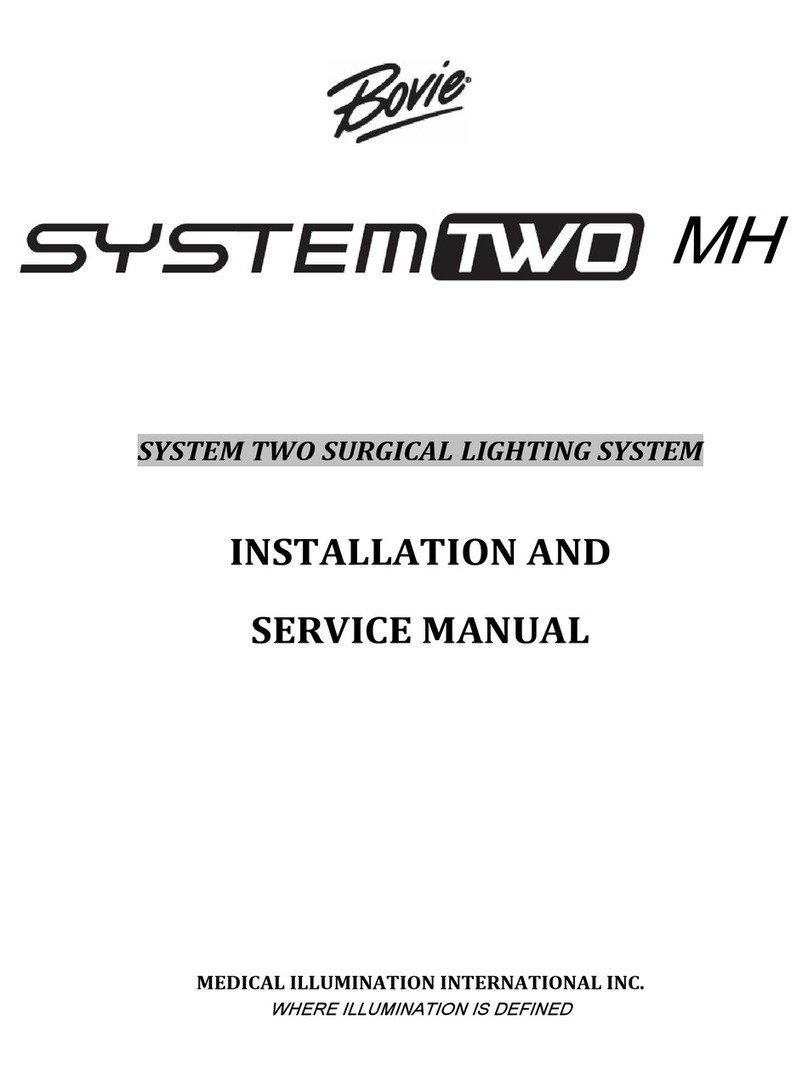
Bovie
Bovie System Two MH Manual
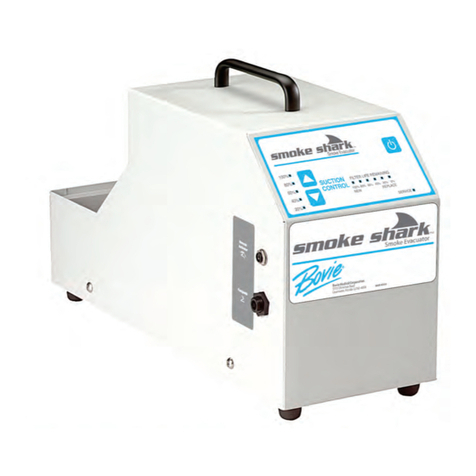
Bovie
Bovie Smoke Shark SE01 User manual
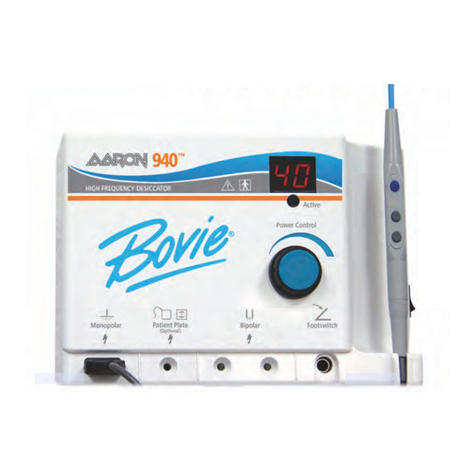
Bovie
Bovie Aaron 940 User manual
Bovie
Bovie Icon Gi User manual

Bovie
Bovie Aaron 950 User manual
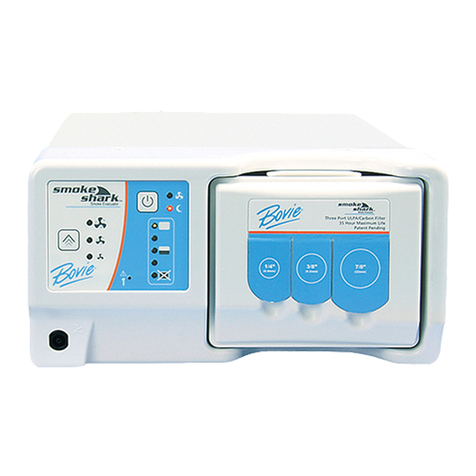
Bovie
Bovie Smoke Shark II User manual
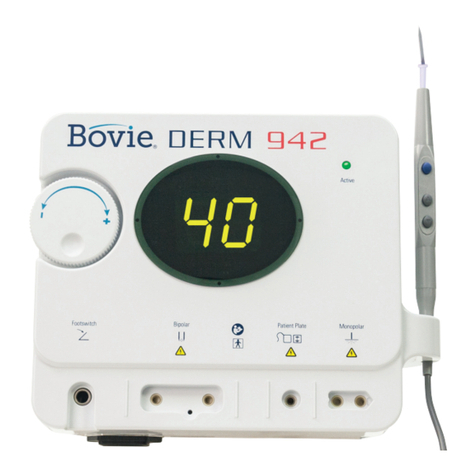
Bovie
Bovie DERM 941 User manual
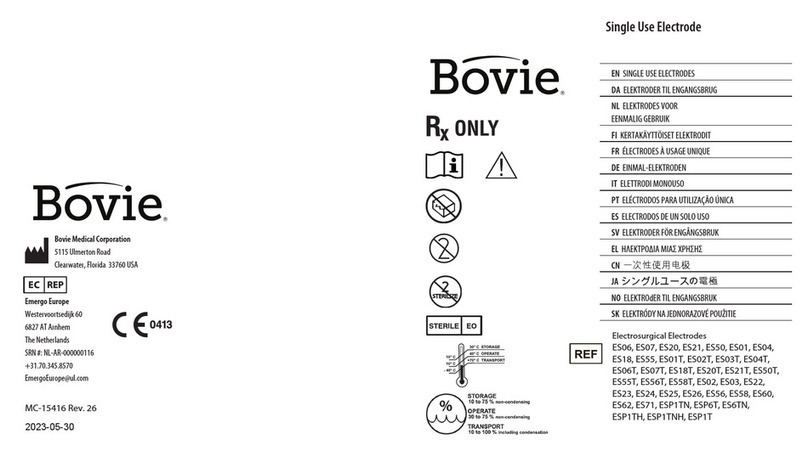
Bovie
Bovie ES06 User manual
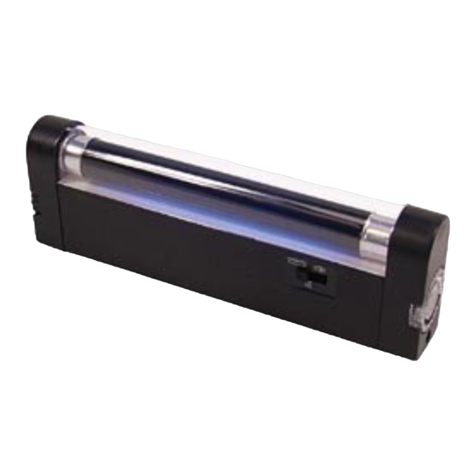
Bovie
Bovie UV59 User manual
Popular Medical Equipment manuals by other brands

Getinge
Getinge Arjohuntleigh Nimbus 3 Professional Instructions for use

Mettler Electronics
Mettler Electronics Sonicator 730 Maintenance manual

Pressalit Care
Pressalit Care R1100 Mounting instruction

Denas MS
Denas MS DENAS-T operating manual

bort medical
bort medical ActiveColor quick guide

AccuVein
AccuVein AV400 user manual
